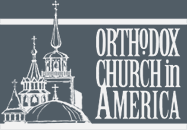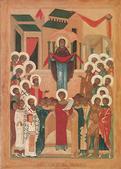
|
Icon of the Protection of the Theotokos (Image)On October 1, 911, at 4 AM, the Mother of God appeared above the people in the crowded Blachernae Church of the Mother of God in Constantinople, during an all night vigil. She had in her outstretched hands a long veil. St. Andrew the Fool for Christ was standing in the back. He said to his disciple Epiphanius, "Do you see how the Queen and Lady of all is praying for the whole world?" Epiphanius replied, "Yes, Father; I see it and stand in dread." They are depicted in the lower right of these icons. This reminds us of how the Theotokos intercedes for those who ask in time of distress. |
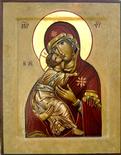
|
The Vladimir Icon of the Mother of God (Image)Known in Greek as Eleousa and in Slavonic as Oumilenie, this icon is also called the Virgin of Tenderness or of Mercy. The relationship between Mother and Child is expressed with stunning force: taking refuge in her, He touches her chin with one hand and presses his cheek against hers. Her pensive, sorrowful eyes foresee his Passion and she embraces him with affectionate, maternal protection. The three golden stars which adorn her mantle, one above the forehead and one on each shoulder, signify her virginity before, during, and after giving birth.
This icon was given by the Church in Constantinople to the Russian Church in Kiev c.1131.When Kiev was destroyed by the Golden Horde, it was removed to the city of Vladimir in 1155. In 1395, it was moved to Moscow. It has been repaired and damaged many times, so that you can see the various layers of painting on it. This is a copy of that icon |
|
|
Tikhvin Icon of the Mother of God (Image)The icon follows the "Hodigitria" model and is similar in style to the ancient Iveron icon of Our Lady. It differs in that the Christ child's legs are crossed, while the sole of His foot is turned to the viewer.
For a complete story of this icon go to http://ocafs.oca.org/FeastSaintsLife.asp?FSID=101821
|
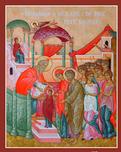
|
Entrance of the Theotokos in the Temple (Icon) (Image)For use as background information only.
When Mary was three years old, her aged parents, Joachim and Anna took her three days journey to present her in the Temple in Jerusalem to fulfill their promise to dedicate her to the Lord's work. The Virgin was clad in royal garments and she was accompanied by a grand procession of her kinsmen each carrying a lighted candle. There were 15 steps leading up to the Temple. Her parents stood her on the first step, then Mary ran to the top. She was received by St. Zacharias, the father of St. John the Forerunner, as he was the High Priest at that time. He took her by the hand and led her into, not only the Holy Place, but into the Holy of Holies. This was the place that only the High Priest was to enter, only on the Day of Atonement. The only explanation is that he was moved by the Spirit of God. Joachim and Anna offered sacrifices to God, received the priest's blessing and returned home. Mary lived in the Temple for nine years. Her parents visited her often until they reposed. She wanted to remain in the Temple all of her days and never marry. The law had no provision for this. It was unheard of for a girl to vow perpetual virginity. So she was betrothed to Joseph. Joseph was an older man whose wife had died leaving him with small children to care for. He needed someone to help him care for the children and she needed someone to protect her in a society that had no place for a single woman. This allowed her to remain a virgin after she left the Temple at age twelve. |

|
Icon of the Nativity of the Theotokos (Image)"Nothing about this event is mentioned anywhere in the Holy Scriptures. But why should there be? Is there anything remarkable, anything especially unique about the normal birth of a child, a birth like any other? And if the Church began to commemorate the event with a special feast, it was not because the birth was somehow unique, miraculous, or out of the ordinary; but because, on the contrary, the very fact that it is routine discloses something fresh and radiant about everything we call 'routine and ordinary, it gives new depth to the "unremarkable" details of human life.
What do we see in the icon of the feast when we look at it with our spiritual eyes? There on the bed lies a woman, Anna according to Church tradition, who has just given birth to a daughter. Next to her is the child's father, Joachim, according to the same tradition. A few women stand by the bed washing the newborn baby for the first time. The most routine, unremarkable event. Or is it? Could it be that the Church is telling us through this icon that every birth, every entrance of a new human being into the world and life is a miracle of miracles, a miracle that explodes all routine, for it marks the start of something unending, the start of a unique unrepeatable human life. The beginning of a new person. And with each birth, the world is itself in some sense created anew and given as a gift to the new human being to be his life, his path, his creation." (Father Alexander Schmemann.) |
|
|
Nativity of Theotokos - Liturgical Texts (HTML)Text of Troparion, Kontakion and Hymn to the Theotokos |
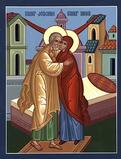
|
Icon of the Conception of the Theotokos (Image)Ss. Joachim & Anna were childless for 50 years of their married life. Then the Archangel Gabriel appeared to them, each separately, and foretold the birth of a daughter. God had heard their prayers. They had always been very devout and gave one third of their income to the Temple, one third to the poor and lived on the remaining third. St. Joachim lived to be 80 and St. Anna lived to be 79. In response to the blessing and the Archangel's prophecy, they dedicated Mary to the Lord and presented her to be raised in the Temple from a young child. |
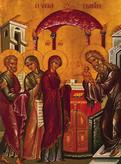
|
Icon of The Presentation (Meeting) of Our Lord (Image)Forty days after Jesus Christ's birth, the Theotokos and her betrothed, Joseph, brought her Son to the Temple to make the customary offering for purification; a pair of turtledoves or two young pigeons. There, the prophetess Anna and the aged Simeon met them. St. Simeon, one of the translators of the Septuagint, sensed the fulfillment of Isaiah's puzzling prophecies of a virginal birth (Isaiah 7:14), and received the young pre-eternal God Incarnate just as he was promised he would before his death. Then St. Simeon praised God and said, "Now lettest Thou Thy servant depart in peace, O Master." |

|
Icon of the Theotokos of the Sign (Image)This iconographic type acquired its name from the prophecy found in Isaiah 7: 14, “Therefore the Lord himself will give you this sign: the Virgin shall be with child, and bear a son, and shall name him Immanuel.”
The Theotokos in this iconographic depiction is most often placed behind the altar in the apse of the church. The Christ Child is found in a circle at the Virgin’s bosom. This reflects Christ having been formed in the Theotokos’ stainless womb. |

|
Akathist to the Icon of the Most-Holy Theotokos (PDF)According to ancient tradition, the wonderworking icon of Our Lady of Tikhvin is one of several painted by Saint Luke the Evangelist. The icon was taken from Jerusalem to Constantinople in the fifth century, where it was enshrined in the Church of Blachernae, which was built especially for this purpose. |

